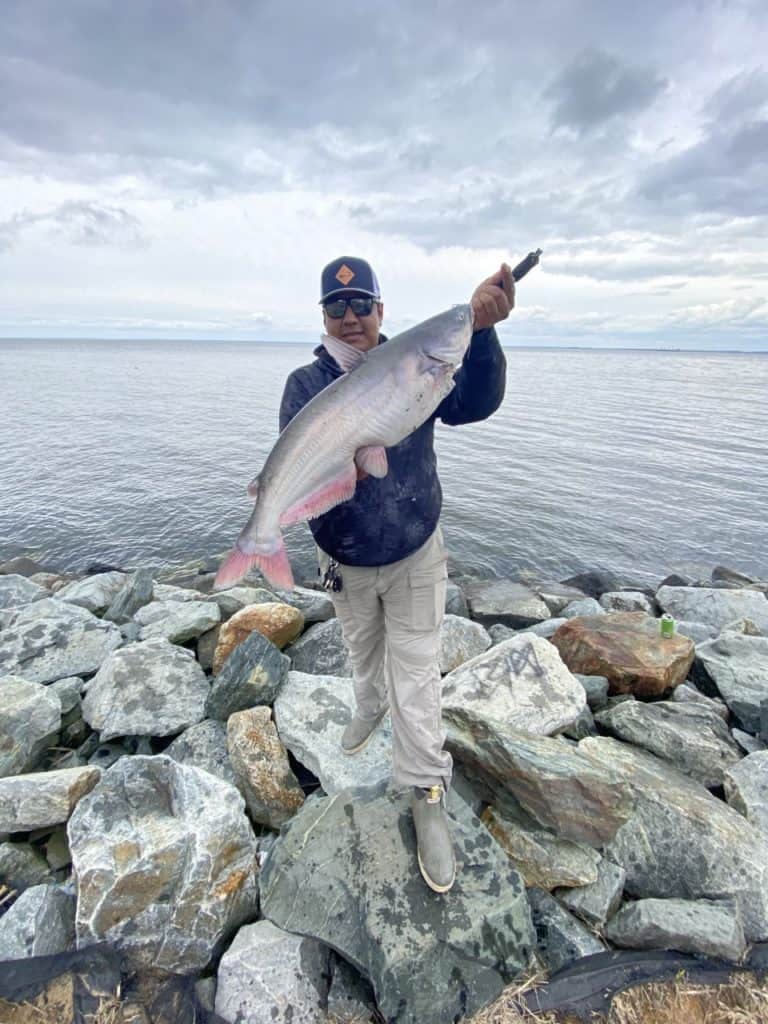The New Bay Blues

What’s big, blue, hungry and all over the Bay?
There are more and more big, whiskered, blue catfish out there cruising the depths. Not only are they sizable, but they are also great eating.
While Maryland remains under an executive order that only allows fishing for one’s dinner (not for sport), blue cats are prime candidates.
Acquiring their name from the pronounced hue of their flanks, the blue catfish is increasingly in residence throughout the Bay and many of the estuaries.
Shoreline fishing as well as boat fishing are very productive methods for these submarine-sized rascals but you’ll need some stout gear: catching a 50-pounder is not out of the question. The James River in Virginia’s portion of the Bay has yielded many blues in the 60- and 70-pound class while the freshwater record is over 140 pounds.
Blue cats from 24-36 inches are the most common find in the mid-Bay and a medium-heavy to heavy action rod with 20- to 50-pound test line will serve well, monofilament being the preferred line in the lower tests and braid for the heavier weights. A sliding, fish finder rig including a 24-inch leader of 30- to 50-pound fluoro, a two-ounce sinker and a 6/0 to 9/0 circle hook completes the outfit.
Heavy duty spin reels with a bait runner feature and stout, round casting reels with a line out alarm will also be helpful. Preferred baits are the freshest available and include gizzard shad, menhaden, white perch, nightcrawlers, crab and even chicken breast. They can be found in waters as shallow as 10 feet and as deep as 50 this time of year. Bottom fishing is the principal option.
Gaffs are legal for landing these interlopers and are very handy. They’re considered an invasive species, native originally to the Mississippi drainage. If you’re intending to net them you’ll need a net with a big, sturdy frame. The opportunity for double-digit harvests, once you’ve located them, are likely.
Blue cats are active during both day and nighttime with the bigger fish cruising the shallower waters and becoming more active during the dark. There is no minimum size nor possession limit. The Chester River has long been famous for its catfish holes in the mid to upper reaches but blue cats are in residence over most of its length. They’ve also recently been reported to be cruising the mouths of other tributaries, particularly the West, South and Severn Rivers and found in 25 to 40 feet depths.
Channel cats have become increasingly common as well, spilled from the Conowingo Dam on the Susquehanna, although usually smaller sized (18 to 24 inches) and a tawny brown color with various small spots the length of their flanks.
Then there are the flathead cats, almost as large as the blues and also reaching 100 plus pounds and also considered an invasive species. They identifiable by their (you guessed it) large, relatively flat foreheads. The table quality of both of these rascals, is almost as high as the blue and all three are currently being harvested commercially.
I’ve eaten catfish prepared many ways but my favorite for all varieties has always been finger sized pieces, dipped in a sticky mix of beer and flour, then rolled in Panko, bread crumbs or cornmeal and fried in 400 degree peanut oil till they’re golden brown. Adult beverages are anyone’s choice but the Southern tradition is ice cold beer in cans and lots of them. Hush puppies, cole slaw and potato salad are the premier accompaniments. Bon appetit.
*****
Fishfinder
As Maryland’s official policy continues to be stay-at-home for all citizens, we would be remiss in suggesting areas to visit. Suffice to say that limitation should be lifted in the near future and we can again begin identifying the where and when to bend a rod. Rockfish season is still scheduled to open May 1, and there have been no postponements thus far for that momentous occasion. Remember to keep a safe distance from contemporaries and stay inside as much as possible until the pandemic passes its peak. Better safe than sorry.
